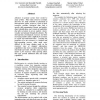Free Online Productivity Tools
i2Speak
i2Symbol
i2OCR
iTex2Img
iWeb2Print
iWeb2Shot
i2Type
iPdf2Split
iPdf2Merge
i2Bopomofo
i2Arabic
i2Style
i2Image
i2PDF
iLatex2Rtf
Sci2ools
CSB
2004
IEEE
2004
IEEE
Navigating through the Biological Maze
Advances in genome science have created a surge of data. These data critical to scientific discovery are made available in thousands of heterogeneous public resources. Each of these resources provides biological data with a specific data organization, format, and quality, object identification, and a variety of capabilities that allow scientists to access, analyze, cluster, visualize and navigate through the datasets. The heterogeneity of biological resources and their increasing number make it difficult for scientists to exploit and understand them. Learning the properties of a new resource is a tedious and time-consuming process, often made more difficult by the many changes made on the resources (new or changed information, capabilities) that stress scientists keeping their knowledge up-to-date. Therefore many scientists master a few resources while ignoring others that may provide additional data and useful capabilities.
Bioinformatics | Biological Data | CSB 2004 | Heterogeneous Public Resources | Specific Data Organization |
| Added | 20 Aug 2010 |
| Updated | 20 Aug 2010 |
| Type | Conference |
| Year | 2004 |
| Where | CSB |
| Authors | Zoé Lacroix, Kaushal Parekh, Louiqa Raschid, Maria-Esther Vidal |
Comments (0)

